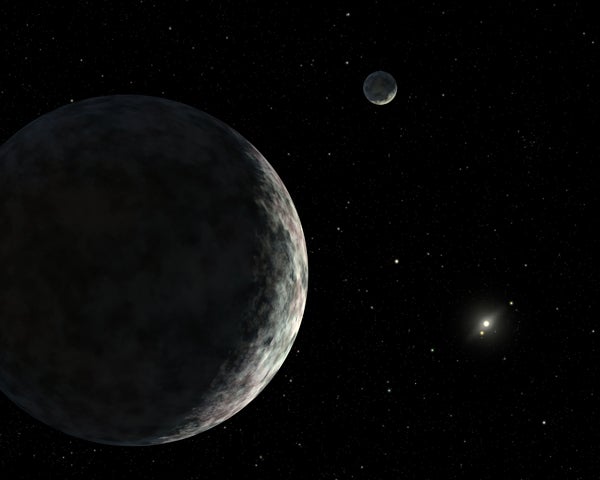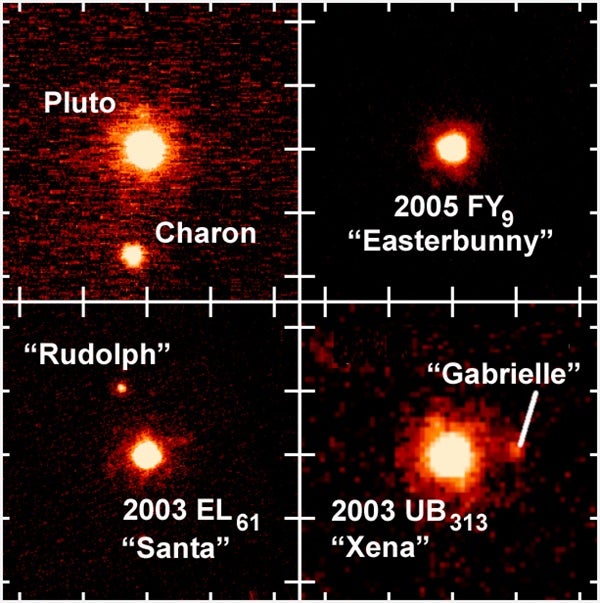On September 30, a team led by Caltech’s Michael Brown announced discovery of a moon orbiting the distant body 2003 UB313. The object, discovered in January 2005, appears to be 20-percent larger than Pluto, leading Brown to dub it the tenth planet. The team has given it the unofficial nickname “Xena,” after the lead character in the TV series Xena: Warrior Princess.
The moon, nicknamed “Gabrielle” after the fictional Xena’s traveling companion, orbits 2003 UB313 about every 14 days. It’s thought to be about 155 miles (250 kilometers) across, or about 9-percent Xena’s size. The moon’s presence “is the only way we could ever measure the mass of Xena,” explains Brown. “A combination of the distance of the moon from the planet and the speed it goes around the planet tells you very precisely what the mass of the planet is.” Brown and his colleagues will track Gabrielle’s motion with the Hubble Space Telescope in November and December, will yield a precise orbit for the moon.
The team found the moon using the newly installed Laser Guide Star Adaptive Optics system on the Keck II Telescope in Hawaii. The system creates an artificial star in an atmospheric layer about 75 miles (120 km) high, then monitors this point for cues to compensate for blurring caused by atmospheric turbulence. The system makes faint detections possible because “observers not only get more resolution, but the light from distant objects is concentrated over a much smaller area,” says team member Marcos van Dam, a scientist at the W. M. Keck Observatory.
“At first we saw this little faint thing that kept cropping up in all the images, and we knew it was not a background star or galaxy because it moved across the sky with the primary,” van Dam explains. “By morning, we knew that we had made a major discovery.”
Xena and Gabrielle, along with Pluto and its moon Charon, orbit in the Kuiper Belt, a swath of icy bodies that stretches from just beyond Neptune to the distant fringes of the solar system. In July, when Brown’s team went public with Xena, the astronomers also announced two other new Kuiper Belt objects — 2005 FY9 (codenamed “Easterbunny” until a formal moniker is approved) and 2003 EL61 (“Santa”). Both are thought to be about three-fourths Pluto’s size, and 2003 EL61 also has a moon (“Rudolph”). Together with Xena and Pluto, they represent the Kuiper Belt’s four brightest members.
“Pluto once seemed a unique oddball at the fringe of the solar system,” Brown says. “But we now see that Xena, Pluto, and the others are part of a diverse family of large objects with similar characteristics, histories, and even moons, which together will teach us much more about the solar system than any single oddball ever would.”
In a paper submitted October 2 to Astrophysical Journal Letters, Brown and his colleagues say the very presence of moons around three of the four brightest — and presumably largest — Kuiper Belt objects makes this group unusual. A recent Hubble survey of 81 objects in the Kuiper Belt turned up only nine satellites.
Moreover, says the team, the moons of Xena and 2003 EL61 are much fainter and smaller in relation to their primary bodies than other satellites in the region. “We were surprised because this is a completely different type of satellite from anything we’ve seen before,” Brown says.
The astronomers suggest the moons formed in a manner different from the gravitational capture envisioned for most Kuiper Belt satellites. Instead, they think the moons formed in a process similar to that credited with creating Earth’s Moon — a giant impact that created a cloud of debris from which the satellite condensed. Simulations suggest this may be the best explanation for the origin of Pluto’s Charon, too.
“When we test collision models to predict how Pluto and Charon formed, the models kept producing tiny satellites, much smaller than Charon,” Brown says. “But we had never seen satellites that small before in the Kuiper belt. But then we found a moon in the Santa system, and then we found another moon circling Xena, and they both look very similar to one another. This leads us to conclude that the largest objects in the Kuiper Belt may have been subject to collisions.”
The discovery of the moon’s primary, Xena, was announced July 29 by Brown, Chad Trujillo of Gemini Observatory, and David Rabinowitz of Yale University. It is now about 9 billion miles (14.5 billion km) away, or about 97 times Earth’s distance from the Sun, and takes 560 years to complete one orbit.
The code names Xena, Gabrielle, and others are unofficial names the astronomers use as a shorthand for the objects’ prosaic and polysyllabic official designations. The astronomers have submitted official names to the International Astronomical Union (IAU), which approves nomenclature in the solar system.
But the IAU has stated it won’t rule on a name for Xena or its moon until the IAU Working Group in charge of defining a planet comes up with a minimum size. The group is considering defining a new class of objects called “trans-neptunian planets.”











